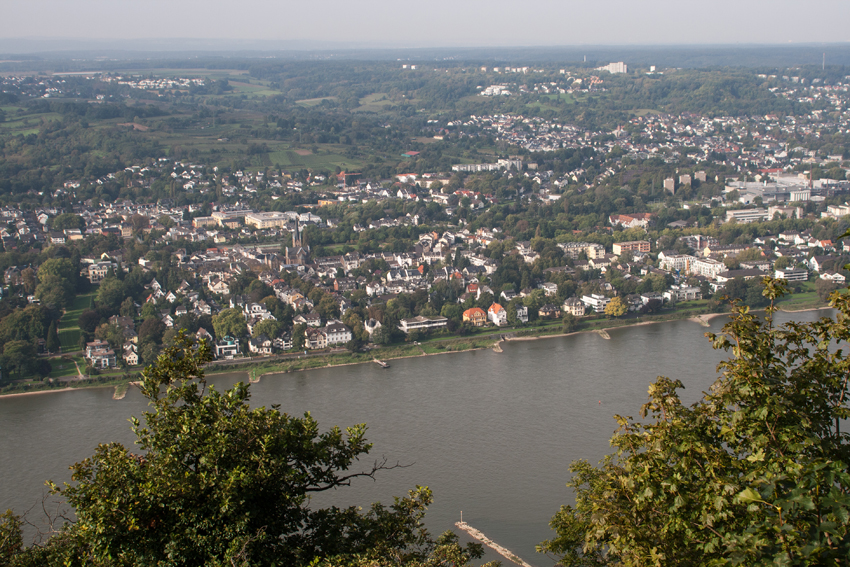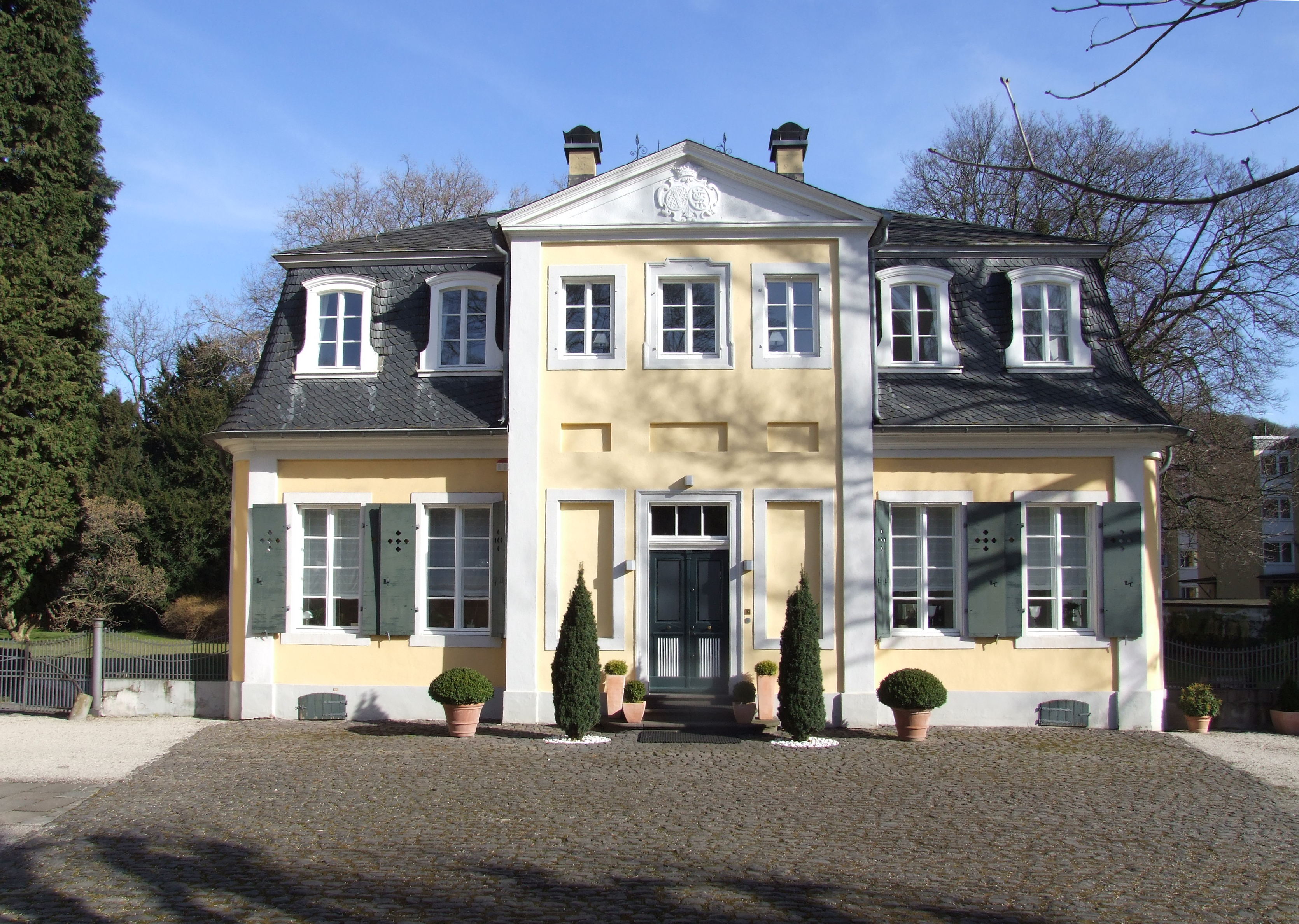|
Oberkassel (Bonn)
Oberkassel is a suburb in the Bonn municipal district of Beuel and lies on the right bank of the Rhine on the edge of the Siebengebirge mountains. Oberkassel has about 7,200 inhabitants. History In 1914, workers in a quarry detected a grave with a 50-year-old man, a 20-25-year-old woman and a dog. Carbon-14 datings estimated an age between 13,300 and 14,000 years. A study of the mitochondrial genome sequences in 2013 showed that the animal is indeed ''Canis lupus familiaris'', not a wolf. Oberkassel was first mentioned as ''Cassele'' in 722/723 and as ''Cassela'' in 1144. The name ''Oberkassel'' refers to a Roman fortification; in the course of time "Romerkastell" (Roman castle) became "Oberkassel". Oberkassel absorbed the previously separate settlements of Berghoven (mentioned for the first time in 873), Büchel (mentioned for the first time in 1202), Broich (mentioned for the first time in 1306) and Meerhausen (mentioned for the first time in 1442). In 1870 the East Rhine R ... [...More Info...] [...Related Items...] OR: [Wikipedia] [Google] [Baidu] |
Wappen Oberkassel
A coat of arms is a heraldic visual design on an escutcheon (i.e., shield), surcoat, or tabard (the latter two being outer garments). The coat of arms on an escutcheon forms the central element of the full heraldic achievement, which in its whole consists of a shield, supporters, a crest, and a motto. A coat of arms is traditionally unique to an individual person, family, state, organization, school or corporation. The term itself of 'coat of arms' describing in modern times just the heraldic design, originates from the description of the entire medieval chainmail 'surcoat' garment used in combat or preparation for the latter. Rolls of arms are collections of many coats of arms, and since the early Modern Age centuries, they have been a source of information for public showing and tracing the membership of a noble family, and therefore its genealogy across time. History Heraldic designs came into general use among European nobility in the 12th century. Systematic, heri ... [...More Info...] [...Related Items...] OR: [Wikipedia] [Google] [Baidu] |
Bonn-Oberkassel Station
Bonn-Oberkassel station is on the East Rhine Railway (german: Rechte Rheinstrecke) in the suburb of Oberkassel in the Bonn district of Beuel in the German state of North Rhine-Westphalia. History The station was opened on 11 July 1870 in the course of extending the East Rhine line from Neuwied to Oberkassel and at the same time as the establishment of the Bonn–Oberkassel train ferry. After the closure of the train ferry in 1919, the station retained its function, since it continued to handle the freight of a cement factory. In addition, it was used by a shipyard newly established in the train ferry precinct. With the decline and final closing down of the cement factory in 1987, the station's freight facilities (several sidings and loading ramps) also lost their importance. Today, of the formerly large field of railway tracks at the station only the two tracks on the East Rhine line are used for freight and commuter trains. The remaining tracks were removed in 2008 along with ... [...More Info...] [...Related Items...] OR: [Wikipedia] [Google] [Baidu] |
Bad Godesberg
Bad Godesberg ( ksh, Bad Jodesbersch) is a borough ('' Stadtbezirk'') of Bonn, southern North Rhine-Westphalia, Germany. From 1949 to 1999, while Bonn was the capital of West Germany, most foreign embassies were in Bad Godesberg. Some buildings are still used as branch offices or consulates. Geography Bad Godesberg is located along the hills and cliffs of the west bank of the Rhine river, in west central Germany. Godesberg is also the name of the steep hill, of volcanic origin, on the top of which are the ruins of the Godesburg, a castle destroyed in 1583 during the Cologne War. History The following events occurred, per year: * 722 - First official record of the town, which was named after a nearby mountain, the Woudenesberg (later Godesberg), a basalt cone where the Ubii, a Germanic tribe, worshipped the god Wotan. * 1210 - On 15 October, Archbishop of Cologne Dietrich I lays the foundation stone of the Godesburg fortress on the Godesberg mountain. * 1583 - On 17 Decemb ... [...More Info...] [...Related Items...] OR: [Wikipedia] [Google] [Baidu] |
Ernest, Count Of Lippe-Biesterfeld
Ernst, Count of Lippe-Biesterfeld (''Ernst Kasimir Friedrich Karl Eberhard''; 9 June 1842 – 26 September 1904) was the head of the Lippe-Biesterfeld line of the House of Lippe. From 1897 until his death he was the regent of the Principality of Lippe. Early life and dispute He was born in Oberkassel the third child of Julius, Count of Lippe-Biesterfeld (1812–1884) and Countess Adelheid of Castell-Castell (1818–1900). On 17 May 1884 Count Ernst succeeded his father as the head of Lippe-Biesterfeld line of the House of Lippe. After the reigning Princes of Lippe, Biesterfeld was the most senior line of the princely house followed by the Counts of Lippe-Weissenfeld and the Princes of Schaumburg-Lippe. On 20 March 1895 the reigning prince of Lippe, Prince Woldemar died childless. His heir was his brother Alexander who was incapable of ruling on account of a mental illness so a regency had to be established. A decree had been issued in 1890 by the late Prince Woldemar and t ... [...More Info...] [...Related Items...] OR: [Wikipedia] [Google] [Baidu] |
Gottfried Kinkel
Johann Gottfried Kinkel (11 August 1815 – 13 November 1882) was a German poet also noted for his revolutionary activities and his escape from a Prussian prison in Spandau with the help of his friend Carl Schurz. Early life He was born at Oberkassel (now part of Bonn). Having studied theology at Bonn and Berlin, he established himself at Bonn in 1836 as a ''Privatdozent'', or theology tutor, became master at the secondary school there, and was for a short time assistant preacher in Cologne. Changing his religious opinions, he abandoned theology and delivered lectures on the history of art, in which he had become interested on a journey to Italy in 1837. In 1843, he married Johanna Mockel (1810–1858), a writer, composer and musician who assisted her husband in his literary work and revolutionary activities. They had four children. In 1846 he was appointed extraordinary professor of the history of art at the University of Bonn. Revolutionary In 1848, with his wife and Carl ... [...More Info...] [...Related Items...] OR: [Wikipedia] [Google] [Baidu] |
German Aerospace Center
The German Aerospace Center (german: Deutsches Zentrum für Luft- und Raumfahrt e.V., abbreviated DLR, literally ''German Center for Air- and Space-flight'') is the national center for aerospace, energy and transportation research of Germany, founded in 1969. It is headquartered in Cologne with 35 locations throughout Germany. The DLR is engaged in a wide range of research and development projects in national and international partnerships. DLR also acts as the German space agency and is responsible for planning and implementing the German space programme on behalf of the German federal government. As a project management agency, DLR coordinates and answers the technical and organisational implementation of projects funded by a number of German federal ministries. As of 2020, the German Aerospace Center had a national budget of €1.261 billion. Overview DLR has approximately 10.000 employees at 30 locations in Germany. Institutes and facilities are spread over 13 sites, ... [...More Info...] [...Related Items...] OR: [Wikipedia] [Google] [Baidu] |
Oberkassel Mitte (SWB)
Oberkassel Mitte is a Bonn Stadtbahn The Bonn Stadtbahn ('' en, city rail'') is a part of the local public transit system in Bonn and the surrounding Rhein-Sieg area, that also includes the Bonn Straßenbahn. Although with six actual Stadtbahn lines (as well as three tram lines) the ... station served by lines 62 and 66. It is located in the suburb Oberkassel. References External links Cologne-Bonn Stadtbahn stations Bonn Straßenbahn stations {{NorthRhineWestphalia-railstation-stub ... [...More Info...] [...Related Items...] OR: [Wikipedia] [Google] [Baidu] |
Oberkassel Nord (SWB)
Oberkassel Nord is a station served by line 66 of the Bonn Stadtbahn and line 62 of Bonn's tram system. This station consists of two tracks with two side platforms. The Bonn-Oberkassel station Bonn-Oberkassel station is on the East Rhine Railway (german: Rechte Rheinstrecke) in the suburb of Oberkassel in the Bonn district of Beuel in the German state of North Rhine-Westphalia. History The station was opened on 11 July 1870 in the co ... is about 450 meters away. References External links {{commons category-inline, Stadtbahnhaltestelle Oberkassel Nord Cologne-Bonn Stadtbahn stations Bonn Straßenbahn stations ... [...More Info...] [...Related Items...] OR: [Wikipedia] [Google] [Baidu] |
Bonn Stadtbahn
The Bonn Stadtbahn ('' en, city rail'') is a part of the local public transit system in Bonn and the surrounding Rhein-Sieg area, that also includes the Bonn Straßenbahn. Although with six actual Stadtbahn lines (as well as three tram lines) the network is relatively small, two of Bonn's Stadtbahn lines connect to the much larger Cologne Stadtbahn (and are numbered according to that system, not Bonn's). The Stadtbahn network comprises of route. There are 64 stations and stops in the city of Bonn proper, and another 17 in Siegburg and Bad Honnef. Additionally, of the Stadtbahn is located underground, as are 12 of the Stadtbahn stations. History In the middle of the 1960s Bonn lay at the heart of five different railway enterprises. Besides the Deutsche Bundesbahn (the West German national railway company) there was the independent Cologne-Bonn railway (KBE) and three separate tram concerns: *The tram network operated by the city of Bonn (SWB), which had declined in the 1950s ... [...More Info...] [...Related Items...] OR: [Wikipedia] [Google] [Baidu] |
West Rhine Railway
The West Rhine railway (German: ''Linke Rheinstrecke'', literally 'left (bank of the) Rhine route') is a famously picturesque, double-track electrified railway line running for 185 km from Cologne via Bonn, Koblenz, and Bingen to Mainz. It is situated close to the western (left) bank of the river Rhine and mostly aligned to allow 160 km/h operation between Cologne and Koblenz and between Bingen and Mainz. Line speed between Koblenz and Bingen is restricted by the meandering nature of the Rhine Gorge, a UNESCO World Heritage Site. History The first section of the line opened on 15 February 1844, by the Bonn–Cologne Railway Company (''Bonn-Cölner Eisenbahn-Gesellschaft'') between the former station of Cologne St. Pantaleon Cologne and Bonn. It was extended on 21 January 1856, south to Rolandseck station and in 1859 north to the Cologne central station. After the takeover by the Rhenish Railway Company (''Rheinische Eisenbahn Gesellschaft'', RhE) on 1 January 1857 t ... [...More Info...] [...Related Items...] OR: [Wikipedia] [Google] [Baidu] |





